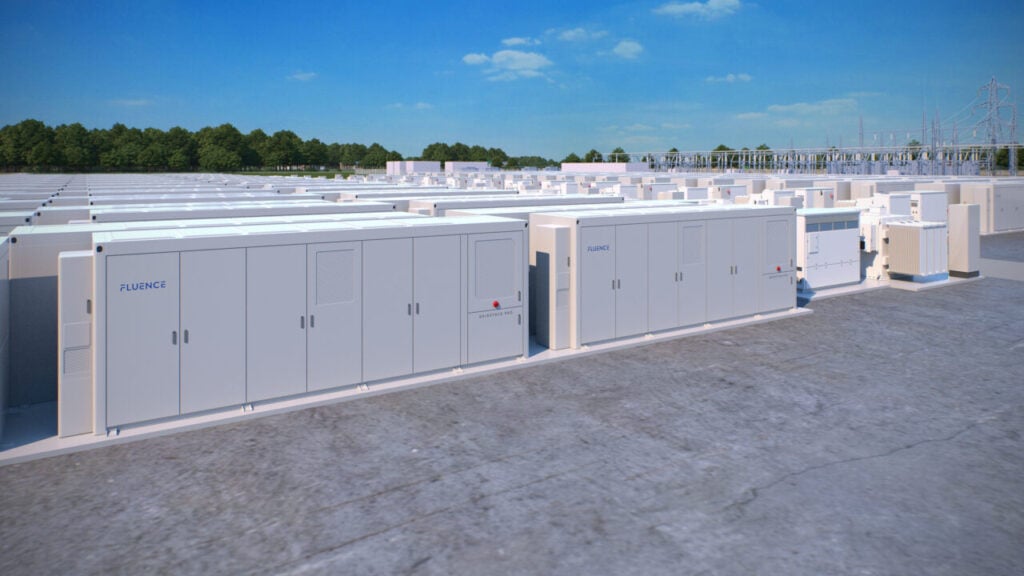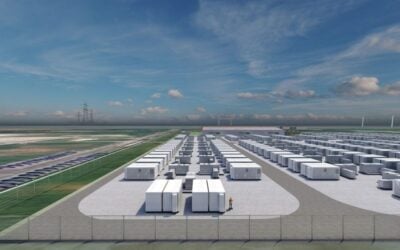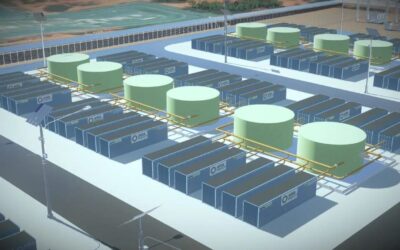
The US market is expected to be the largest source of revenue and driver of activity for Fluence in 2026, and a second battery cell deal with a domestic supplier is imminent.
Battery energy storage system (BESS) integrator, manufacturer and renewable energy software services provider Fluence issued revenue guidance for the next fiscal year and reported its latest yearly and quarterly financial results and held an earnings call earlier this week (24, 25 November).
The company reported US$1 billion in revenue for the quarter just ended and US$2.3 billion in revenue for its fiscal year 2025, which ended 30 September 2025. The yearly figure was around US$300 million below guidance, attributed to a delay in ramping up a BESS enclosure factory in Arizona, a key part of its strategy to meet demand for domestic content in the US.
Its quarterly GAAP gross profit margin for fiscal year 2025 was 13.1%, and CFO Ahmed Pasha noted in an earnings call that adjusted gross margin was above 13% in every quarter of the year, after starting FY2024 with 7.6% gross margin and improving its position sequentially throughout.
Try Premium for just $1
- Full premium access for the first month at only $1
- Converts to an annual rate after 30 days unless cancelled
- Cancel anytime during the trial period
Premium Benefits
- Expert industry analysis and interviews
- Digital access to PV Tech Power journal
- Exclusive event discounts
Or get the full Premium subscription right away
Or continue reading this article for free
Fluence ended the reported period with total liquidity of US$1.3 billion, comprising US$715 million in cash and US$556 million available under credit facilities. CEO Julian Nebreda said that this left the company “in a strong position to fund our plans for growth.”
The company reported a net loss of US$68 million for the year, versus US$30 million net income in FY2024, but while Nebreda said spending on sales and product initiatives would impact 2026 numbers, Fluence expects operating expenses to grow at less than half the pace of revenue.
For this coming year, Fluence issued revenue guidance of between US$3.2 billion and US$3.6 billion, with a US$3.4 billion midpoint, annual recurring revenue from service contracts and software services of approximately US$180 million and adjusted EBITDA of US$40 million to US$60 million with a midpoint of US$50 million. Adjusted EBITDA for FY2025 was US$19 million. This was at the upper end of the revised US$0 to US$20 million guidance issued in Q2 2025, following an initial guidance of US$70 million to US$100 million before the start of the last fiscal year.
Data centres, LDES opportunities in pipeline
Q4 2025 order intake was US$1.4 billion, a quarterly record for the company, driven primarily by orders in Australia, with APAC region deals comprising 50% of the total, EMEA around 20% and the Americas about 30%.
However, as mentioned above, despite the strong showing for APAC deals and the securing of a 1GW/4GWh project with German power producer LEAG—Europe’s largest single project deal to date—the US is expected to be the biggest component of next year’s activity.
Of a claimed US$23.4 billion utility-scale BESS pipeline of opportunities, 45% are in the Americas, 30% in EMEA, and 25% in APAC.
Fluence said over 30GWh of its pipeline is data centre projects, the majority behind-the-meter (BTM) solutions, and over 80% of which originated during Q4 2025. Data centres are increasingly being seen by some BESS providers as a potential ‘golden opportunity’ to manage the power fluctuations AI computing loads create and rapidly add the necessary capacity.
Over 60GWh is long-duration energy storage (LDES) tenders of 6-hour to 8-hour duration in renewable energy-driven markets, including the UK, Germany, Italy and the US. Fluence is among the lithium-ion (Li-ion) BESS providers that see its technology as competitive for LDES applications, particularly its high-energy-density Smartstack solution. Smartstack has up to 7.5MWh capacity per unit and allows for more than 500MWh of storage per acre.
That said, overall, Fluence expects the majority (70%) of its 2026 revenue to come from its Gridstack Pro BESS solution, launched in 2023 to meet demand for complex, large-scale projects, which can fit up to 5.6MWh of storage capacity within the standard 20-foot ISO container form factor.
Projects are getting bigger on average, too, with the pipeline including 38 deals of at least 1GWh, more than double the number last fiscal year.
US domestic cell supply increase
CFO Pasha stated that the growth plans referred to by Nebreda include approximately US$200 million in investments planned for the new fiscal year. Around half of that will be spent on domestic supply chains, and the other half on working capital to support an anticipated 50% growth in revenue for 2026.
As regular Energy-Storage.news readers will be aware, Fluence has long viewed a domestic content strategy as a key factor in success in the US market. It is now able to manufacture nearly everything through its own US manufacturing facilities, except for battery cells and power conversion system (PCS) equipment.
The delay in ramping up the Arizona plant, which impacted revenues, had been previously referred to by CEO Julian Nebreda in August as a consequence of a longer-than-anticipated time required for technology transfer from its 35GWh annual production capacity manufacturing base in Vietnam.
Nebreda said in yesterday’s call that improvements have been made at the Arizona plant, and production rates improved. The Arizona factory is complemented by other Fluence-owned sites in Utah (module production) and Texas (HVAC and thermal management).
The newest Smartstack product is presently only made at its Vietnam factory, which serves overseas markets outside the US. Then-Fluence Americas president John Zahurancik, who is now its chief customer success officer, told ESN Premium in a recent interview on domestic content strategy that a decision had yet to be made on where Smartstack would be assembled for shipping to US customers.
According to discussions in previous earnings calls, around half of its US cell supply currently comes from the Tennessee factory operated by AESC. The rest comes from manufacturers based in Asia. With foreign entity of concern (FEOC) restrictions on investment tax credit (ITC) eligibility incoming and growing customer preference for domestic supply, Fluence is working to source solely from ‘Made in America’ suppliers.
The company is negotiating with a second cell supplier. Pasha said capacity from that deal is expected to be available “in about the next 10-11 months,” but noted that current supply should be sufficient to serve around 85% to 90% of its revenue backlog.
“We have already secured the capacity for that, so we don’t need this capacity but we are now locking in additional capacity to basically secure our future business,” the CFO said.
It is also working with AESC to establish full prohibited foreign entity (PFE) compliance and expects to do so before regulatory deadlines, CEO Nebreda said.





